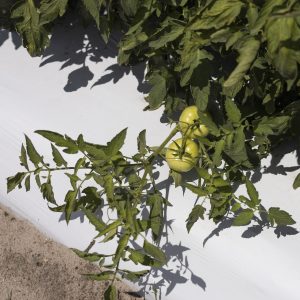
Two studies on tomato production are giving farmers more sustainable options for fertilizer use and maintaining soil health. UF/IFAS researchers explored the use of controlled-release urea (CRU) compared to conventional soluble urea (U) in one study. The other focused on the impact of standard tomato production on plant and soil carbon (C) and nitrogen (N) dynamics. It also examined the effect of N fertilization rates on tomato plants and soil depth. Both studies took place at the University of Florida’s Plant Science Research and Education Unit in Citra, Florida.
Nitrogen Use Efficiency and Yield Levels Using Soluble and Controlled-release Urea Formulations in Tomato Production
In this study, conducted over two years in north Florida, researchers focused on the impact of N sources and management on tomato yield, N use efficiency (NUE), and apparent recovery of N fertilizer (APR).
Dr. Laura Jalpa, a postdoctoral associate in the UF/IFAS Department of Soil, Water, and Ecosystem Sciences, led both research studies.
“Our findings suggest that CRU can have a significant impact in tomato farming, offering a low-risk alternative N source,” she said.
The experiment involved three urea N sources – one soluble and two polymer-coated CRU sources (one lasting for 60-days and another for 75-days). They applied these at different N rates (140, 168, and 224 kilograms per hectare). Notably, fall yields consistently surpassed spring yields by at least 20%. APR and NUE were optimal at the 140 kg/ha N rate, particularly in fall tomato crops.
“If north Florida tomato farmers adopted CRU fertilizers, they could potentially reduce N rates by 38%,” Jalpa noted. “This would be a significant time and money saving move as well as lessen harmful impacts on the environment.”
Another observation was the lower APR values in spring production seasons compared to fall. This points to residual soil N being a significant source for tomatoes. The mean whole-plant N accumulation was 102.5 kg/ha, underscoring the potential for optimizing N rates to meet crop demand efficiently.
Current tomato production practices and their effects on plant and soil carbon and nitrogen dynamics
The other study assessed the impact of standard tomato production in north Florida on plant and soil C and N. The research evaluated C, N, and C:N ratios at harvest in the spring and fall seasons of 2017.
In a replicated field study, ammonium nitrate as the N source was applied at varying rates (0, 168, 224, and 280 kg/ha) through drip irrigation. Despite different N rates, whole plant C:N ratios remained consistent in both seasons, indicating optimal N uptake by the tomato crop. Soil total carbon (TC) and total nitrogen (TN) concentrations were unaffected by varying N rates. Jalpa said this suggests a lack of fertilizer input response.
“The study indicates that reducing N fertilizer rates can enhance the sustainability of vegetable production systems in sandy soils under warm climates,” Jalpa concluded.
As farmers seek ways to achieve sustainable agriculture, these findings for north Florida tomato farmers present several options. It shows CRU is a promising alternative and promotes a balanced nutrient management approach for improved ecological outcomes.
Full details of the studies are available here:
 0
0
